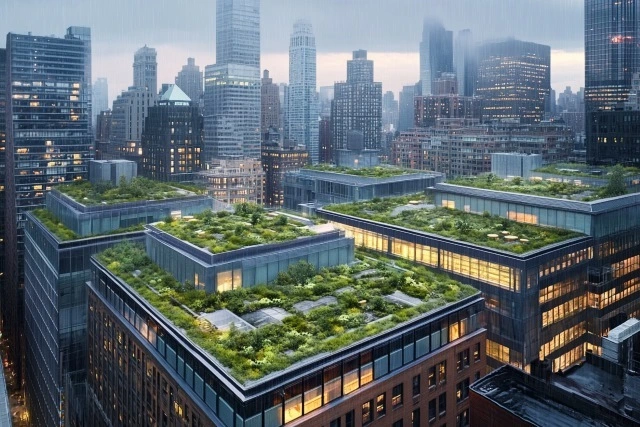2024 was officially the warmest year on record. For the first time since records began, global mean temperatures rose above the pre-industrial average by 1.5°C, beyond the limit set by the Paris Agreement in 2015. Within a decade, we have seen temperatures increase consistently year-on-year, and many of the world’s leading economies — the US, China, UK, EU, and Brazil, continue to fall short of their agreed climate targets.
Amid this climate crisis, there are regular reminders of the human cost of rising temperatures. Warmer oceans lead to more intense tropical activity, leading to stronger hurricanes and tropical storms. There were 27 separate climate disasters in the US in 2024 that caused more than $1bn worth of damage, including Category 4 Hurricane Helene, which claimed 219 lives. More than 1,200 people were also killed in typhoons in the Pacific, and the Philippines saw no less than six deadly storms in 30 days.
Extreme weather is already causing a massive strain on our built environment. Our homes and places of work will need to be more resilient to cope with the demands of extreme weather and more proactive in minimizing their greenhouse gas emissions to reduce their climate impact.
The commercial real estate industry shoulders its share of responsibility in shielding its tenants from the extremities of our natural world. Proptech startups have already proven their capacity to solve a range of sustainability challenges, from energy efficiency to process automation. This blog will explore how the sector can build climate resilience in a changing world.
CRE’s Climate Reality Check
Wherever you are in the world, no business is immune to the effects of the climate crisis. According to the Intergovernmental Panel on Climate Change (IPCC), more than 40% of the world’s population is considered to be “highly vulnerable” to climate disasters such as floods, droughts, and wildfires. These scenarios will affect businesses financially as well as on a human level. Deloitte estimates that the average monthly insurance cost for a commercial building in the US will rise from $2,726 in 2023 to $4,890 by 2030.
The sector and its investors face a variety of direct and indirect risks as the climate crisis deepens, from the physical property damage caused by extreme weather to increased market volatility and regulatory pressure to decarbonise. The scale of investment required to mitigate these risks will require a historic transfer of capital; in New York, for example, it’s estimated that retrofitting all of Manhattan’s 50,000 buildings to comply with Local Law 97 would create more than $24bn of retrofit demand by 2030.
How Modern Buildings Are Mitigating Climate Disasters
In this challenging commercial landscape, CRE businesses have a responsibility to make significant progress towards more sustainable operations. Firms don’t just set ambitious ESG targets to attract eco-conscious investors; they do so to ensure their operations will stand the test of time. The severity of climate change in our world today means the sector can no longer sit on its hands without taking action.
Constructing Climate-Resilient Buildings in High-Risk Areas
Humanity has consistently proven its ability to adapt to extreme environments with grand infrastructure projects. The Netherlands has consistently invested in flood prevention methods to protect the 60% of its population in coastal communities at risk of rising sea levels.
World-leading building design can also offer some inspiration. A beacon of sustainability with a LEED platinum rating, Taipei 101 has been built to withstand the strongest of tremors in quake-prone Taiwan thanks to a 660-ton steel pendulum that acts as a counterweight during earthquakes.
While such technology might seem out of reach, Japanese cities have demonstrated their earthquake resilience through their commitment to tremor-proof design since Tokyo was left in ruins after a deadly quake in 1923.
Designing climate-resilient buildings requires tight collaboration between architects, developers, contractors, and investors to ensure structures are built with the specifications needed to withstand the impact of disasters in the area in which they will stand. This can take shape in various ways, from better insulation against heatwaves to buoyant buildings that fight against the risk of coastal flooding.
Proptech’s Role in Shielding CRE from Extreme Weather
Structural design and property technology often go hand-in-hand. If you were procuring a building to be optimized for sustainability, you’d lean into the principles of green building design while investing in smart systems like building automation and energy management systems. The same is true for disaster prevention, and proptech is advancing in a number of key areas that can help shield your CRE business from extreme weather.
Digital twin technology is one such example. Advanced computer modelling and machine-learning algorithms enable real-time simulation and analysis of a building’s performance, and they can be used to project how a structure might perform in extreme conditions. The European Space Agency are already utilizing digital twins to manage water levels and prevent disasters in the Mediterranean Sea, and is in the process of expanding this model to create a full twin of Earth itself.
IoT and cloud-based monitoring systems can also aid building managers, as these systems can automatically initiate protective protocols in the event of extreme weather. Let’s say your CRE business manages a high-rise building during a severe storm. In this case,the IoT network would automatically retract external shade structures and adjust internal pressure to prevent window damage, while optimizing HVAC systems to handle sudden temperature changes.
From Wildfires to Floods: How Technology Predicts the Unpredictable
If we take these exciting technological advancements and apply them across commercial districts and residential communities, it is possible to imagine interconnected smart cities where buildings communicate with each other in climate disaster scenarios.
Sensor technology can play a vital role in preparation and response to extreme events. Sensors can detect water, fire, and high winds and automate the building’s response within seconds. Building management systems can divert power to mitigate outages elsewhere, and their data can support first responders with vital information needed to save lives.
Proptech can be used to predict the unpredictable, and leading nations in disaster-prone areas are leading their investment in proptech to support their built environment.
Japan is often recognised as a world leader in its preparedness for climate disasters, but almost 14 years on from the Great East disaster of 2011, authorities in Tokyo are now utilizing AI algorithms to detect structural damage and fires caused by earthquakes and tsunamis. It can use building data to direct emergency services towards vulnerable areas, saving lives before it becomes too late.
The Singaporean government has also embraced high-tech solutions to protect buildings and lives following deadly floods in 2011. The country became the first to adopt a nationwide digital twin system, capturing over 160,000 satellite images of the city and its core infrastructure. Not only does this support decarbonization by optimizing city-wide utility resource allocation, but it can play a vital role in disaster preparedness through advanced simulations to prepare authorities for the worst.
The New ROI: How Climate Tech Preserves Property Value
The CRE sector must be prepared for all eventualities with the climate crisis set to intensify throughout the 2020s and beyond. It must consider carefully what it means to be sustainable in an ever-changing world, going beyond decarbonization for the sake of an arbitrary net-zero target to provide meaningful social value for its stakeholders and tenants.
Climate technology can be transformative in this era. Digital twin systems and IoT networks act as the eyes and ears of core infrastructure, alerting facilities managers to potential dangers before they become critical to allow time to react. This can preserve building integrity and save the lives of its occupants.
Green buildings aren’t just better prepared for climate change; they are also more likely to preserve their value in an increasingly volatile market. Our research indicates LEED-certified buildings can command a 37% price premium over their competitors. ESG-driven investors increasingly turn to commercial buildings that demonstrate their sustainability credentials, incentivizing those businesses that invest in their buildings’ long-term future.
Invest in your CRE business with ProptechOS
It is a challenging time to be managing a commercial property portfolio. CRE businesses worldwide feel the long-term impacts of the COVID-19 pandemic, global political instability, and worsening climate crisis. Responding to these adversities requires bold, strategic thinking, prioritizing asset sustainability and profitability over all other goals.
ProptechOS realizes CRE firms’ challenges in preparing their portfolios for harsher climates and rising energy costs. Our Operating System for Real Estate allows leaders to optimize energy use, reduce carbon footprints, and meet ESG standards efficiently. Help your properties to perform at their best and empower your facilities management teams to preserve your portfolio integrity in all conditions.
As Al Gore once said, “We have the solutions, but we’ve got to move faster.” With ProptechOS as your sustainability partner, we can transform your portfolio’s environmental performance quickly and at scale.
Your CRE business can sign up for a free trial of ProptechOS today.

